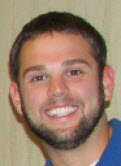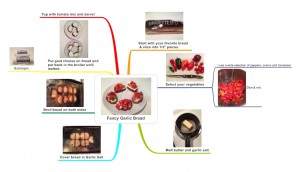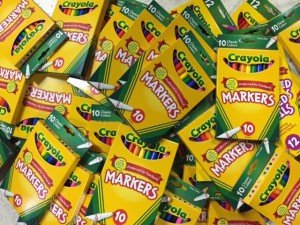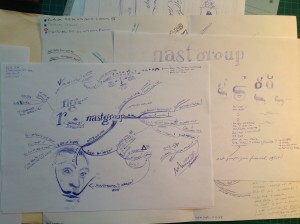An Idea Mapping Success Blogs Weblog
Idea Map 476 – AGT Top Ten Finalists. Who will win $1 million tonight?
16 Sep 2015 Author: Jamie Nast In: Idea Mapping ExampleJamie Nast Interviewed by Biggerplate’s Liam Hughes on this Google Hangout
14 Sep 2015 Author: Jamie Nast In: Biggerplate, Interviews If you didn’t get a chance to see this interview, you may want to check it out. Liam has changed his monthly hangout format and is now interviewing mind mapping practitioners. I was honored to be the first!
If you didn’t get a chance to see this interview, you may want to check it out. Liam has changed his monthly hangout format and is now interviewing mind mapping practitioners. I was honored to be the first!
- 0 Comments
- Tags: Biggerplate, Jamie Nast, Liam Hughes
Part 3 of Introducing the First Idea Mapping Guest Blogger – Chris Kordick
24 Aug 2015 Author: Jamie Nast In: Interviews Part 1 of this interview was posted on August 12, 2015 and part 2 was posted on August 15, 2015. This is the third of three posts about Chris Kordick who is the first Idea Mapping Guest blogger. Currently Chris is in his first year of med school at Lake Erie College of Osteopathic Medicine.
Part 1 of this interview was posted on August 12, 2015 and part 2 was posted on August 15, 2015. This is the third of three posts about Chris Kordick who is the first Idea Mapping Guest blogger. Currently Chris is in his first year of med school at Lake Erie College of Osteopathic Medicine.
Following are questions 8-10 of my interview with Chris:
8. What do you see as the benefits to using Idea Mapping?
There are many benefits, however, I’ll list the top three:
1. It allows the reader/student to actively copy down text, notes, and lectures, which allows them better recall of that information in the long run.
2. It provides the student with a chronological map of his/her study materials allowing them to study more efficiently—saving time and stress!
3. It allows the student to be colorful, creative, and fun while studying materials that are both interesting and dull. Let’s face it; every student must study something that is unappealing at some point in his or her career—why not make it creative and colorful?
9. Why do you prefer hand-drawn maps to using software?
I want to preface this by stating that software is not a bad tool, however, it is not for everyone! That being said I prefer hand drawn maps because “what the hand writes, the mind remembers.” Software programs are efficient, neat, and extremely powerful, but consciously copying things down in my own shorthand allows me to map out my notes in my mind as well as on paper. Many times during testing I was able to pull up snapshots of my maps because I could remember that I smudged a section in the upper right quadrant of the page, or that I wrote down a silly pneumonic next to a coffee stain. Those other environmental notes that appeared on the map acted as road signs for my recall.
10. Can you tell us a bit about your story and how you got to where you are today?
After graduating high school in Michigan, I knew that I wanted to study the sciences and attend medical school—I just didn’t know how God was going to make that happen. So I decided to have some fun with it and start off my collegiate career as a baseball player attending Benedictine University in Lisle, Illinois. About a year in, I had a severe injury that inhibited me from playing the rest of my college years, so I turned my focus from being a student-athlete to being a student-coach. Going through surgery and rehabilitation allowed me to share my experiences with other athletes and focus on things such as athlete health and injury prevention while coaching. It was during this time that I had seen my curiosity for sports medicine and exercise physiology ignite. My junior year I became the strength and conditioning intern for the baseball program and was able to take my talents into the weight room where I prepared our team for a season that ultimately allowed them to compete in the national tournament. During this time, I was able to use Idea Mapping to assist in my studies, as well as program development, to help me obtain a perfect grade point average, and create some insanely strong athletes. My senior year, I was asked to assist with multiple research projects through the university’s exercise physiology program. During the course of this research, I was able to present an abstract at the American College of Sports Medicine annual meeting and met some highly qualified, really awesome individuals. Now, after completing my bachelor’s degree and successfully taking the MCAT, I will be entering medical school this fall. It has been a wild ride thus far, but it’s only getting better!
Idea Map 475 – Fancy Garlic Bread Recipe
22 Aug 2015 Author: Jamie Nast In: Idea Mapping Example This is one of our favorite summer recipes. I use fresh tomatoes and peppers from our organic garden and a fresh bread.
This is one of our favorite summer recipes. I use fresh tomatoes and peppers from our organic garden and a fresh bread.
Delicious appetizer!
- 0 Comments
- Tags: Fancy Garlic Bread, Recipes
Part 2 of Introducing the First Idea Mapping Guest Blogger – Chris Kordick
15 Aug 2015 Author: Jamie Nast In: Interviews Part 1 of this interview was posted on August 12, 2015. This is the second of three posts about Chris Kordick who is the first Idea Mapping Guest blogger. Currently Chris is in his first year of med school at Lake Erie College of Ostepathic Medicine.
Part 1 of this interview was posted on August 12, 2015. This is the second of three posts about Chris Kordick who is the first Idea Mapping Guest blogger. Currently Chris is in his first year of med school at Lake Erie College of Ostepathic Medicine.
Following are questions 4-7 of my interview with Chris:
4. How did you apply the Idea Mapping and memory tools to help you study or the MCAT? What were the results?
Idea Mapping for the MCAT was difficult, though, at times it became very beneficial. Certain parts of the MCAT require one to utilize equations and stone-cold factual information, which made the dynamic structure of Idea Mapping difficult for me to harness; however, I was able to utilize it for much of the biological sciences section. Things like human physiology and microbiology were great subjects to map because a majority of the questions asked on the exam were thought questions.
5. How are you applying the Idea Mapping and memory tools today?
I use them in a few different ways today. In my application to medical school, I used the tools to map things like my personal statement and essay questions. I feel that it helped me create drafts of documents that were crisp and appealing, rather than long-winded. Also, by using the mapping tools during my academics, I have noticed that I have become a more creative thinker during the course of the day. If asked a question, or trying to solve a problem, I’ve noticed that I have become more abstract in my thinking. Studying in the sciences, I have always been told that things are logical by nature. After becoming efficient at Idea Mapping, I’ve noticed myself thinking more creatively by straying away from the black and white; instead, I find myself asking “What if…?”
6. How do you plan to apply the Idea Mapping and memory tools while at Med School?
I plan to use them primarily on my text and lecture reviews because of the efficiency they provide me while studying; however, things like the “Roman Room” will be great to use when going over things that require rote memory.
7. Do you envision using these tools in your profession as a physician?
To be honest, it’s a bit early for me to give a solid answer, however, because these tools allow me to recall large amounts of information quickly while allowing me to retain my creativity, I think that I will find many ways to harness the power of Idea Mapping.
Thanks Chris for your time. Look for the third and final interview, some of Chris’s idea maps fresh from Med School, and future blogs from this brilliant young man! I look forward to sharing the final interview with you.
Are You a Teacher?
13 Aug 2015 Author: Jamie Nast In: Idea Mapping Workshops A few days ago I found fine point markers and colored pencils on sale at Meijer for $1.00 each thanks to back-2-school incentives. I loaded up my my cart with 30 sets of each and continued my shopping. That’s when the questions began.
A few days ago I found fine point markers and colored pencils on sale at Meijer for $1.00 each thanks to back-2-school incentives. I loaded up my my cart with 30 sets of each and continued my shopping. That’s when the questions began.
As I made my way up and down the isles of the store, nearly every person I ran into asked, “So are you a teacher?”
To briefly explain idea mapping and how the markers and pencils are used during my workshops is more than what a stranger really wants to know, so my response was, “I teach learning workshops for adults and we use lots of color.”
Then I got caught in a long wait at the no-limit self checkout. The woman behind me asked if I was a teacher (again), and this time I explained at bit more. It took me so long to check out (one scan at a time) that my new friend helped bag markers, pencils and groceries!
Introducing the First Idea Mapping Guest Blogger – Chris Kordick
12 Aug 2015 Author: Jamie Nast In: Interviews Today I’m welcoming Chris Kordick as the first guest blogger to this site. I’ve known Chris since 5th grade. He took my Idea Mapping Workshop in August of 2013.
Today I’m welcoming Chris Kordick as the first guest blogger to this site. I’ve known Chris since 5th grade. He took my Idea Mapping Workshop in August of 2013.
In his early 20’s Chris join an elite group of some of the most prolific Idea Mappers I have ever taught. His extensive use of idea maps and memory tools set him apart and give him much credibility – therefore the invitation as a guest blogger.
I first posted about Chris in the fall of 2013 when he was in his last year of pre-med at Benedictine University in Chicago. You can see those two postings about Chris at Idea Map 436 – 1-Year Weightlifting Program Design and Cardiovascular Physiology Student Gets a 92 While Class Average Was 63. How Did He Do It?
Chris is a busy man in his first year of med school at Lake Erie College of Ostepathic Medicine, so we won’t expect frequent posts. But first I need to re-introduce him. Following is the first of three postings about Chris. I recently had the opportunity to interview him. Here are his answers to the first three questions:
1. Prior to attending the Idea Mapping Workshop did you have any preconceived notions about the tool?
In short answer, yes. I am by no means artistic and when I thought of “mapping” I instantly assumed drawing and design. I wondered if the skills taught in the workshop would 1) be applicable to my studies in college and 2) be useful in helping me capture and retain large amounts of information from both lectures and various texts.
2. What were some of the takeaways you had from the course?
I had many! The main one was that Idea Mapping is a set of dynamic skills. One doesn’t need to be Picasso to draw a beautiful map, he/she must simply use whatever means necessary to help with memory retention. Another large takeaway was the ability to condense large amounts of information to a chronologically built map. If noting chapters 1-2 of a dense text, I could do so in order using my own shorthand to create a picture of words that assisted in my recall and retention.
3. How did you apply the memory tools to your schoolwork? What were the results?
I did so in a few different ways. To be honest, I tried to use Idea Mapping live during my lectures, but failed to fully capture all of the information. Instead, I focused from live mapping to study-style mapping. When I would review my linear notes and read my textbooks, I would map out the chapters and turn the linear thoughts into dynamic ones. I also used this technique during pre-recorded lectures because I was able to play them back at reduced speed or pause them as needed.
Once I had my notes, I would read over them and study them in chronological order. Most of my classes at the time were systems based, and the Idea Mapping allowed me to take the text from the book and piecemeal it together in colorful ways; when studying, this was extremely useful because I could zero in on specific points without funneling through my entire text/lecture notes. It saved invaluable amounts of time and allowed me to remember my notes based on color, pictures, etc.
The results were exciting. I had always been a good student before, but I struggled very hard with test taking. Idea Mapping allowed me to score better on both my multiple choice, and short answer exams! By using the memory tools and Idea Mapping, I was able to pull information out of my memory faster and answer multiple choice questions more effectively because I could call more facts to mind than before. My long-term memory recall had drastically improved which allowed me to review for final exams instead of study for them. While my classmates had to flip through notebooks and PowerPoints full of information, I simply pulled out my ten idea maps (one for each chapter) and reviewed.
Thanks for your time Chris! I look forward to sharing the rest of the interview with you.
Idea Map 474 – About Putting For Golfers
20 Jul 2015 Author: Jamie Nast In: Idea Mapping Example In October of 2007 I posted a fantastic idea map from Paul Shorock titled “About Golf.” While sharing this map with two classes at Boeing last week, I realized that I never posted the second one Paul gave me specifically on putting.
In October of 2007 I posted a fantastic idea map from Paul Shorock titled “About Golf.” While sharing this map with two classes at Boeing last week, I realized that I never posted the second one Paul gave me specifically on putting.
At the time these were created Paul’s purpose was to explain golf’s rules and etiquette while introducing his new son-in-law to the game.
Both of these idea maps were created using MindManager. Happy putting to all you golfers.
Using Mind Maps Magazine Celebrates Its 2-Year Anniversary
31 May 2015 Author: Jamie Nast In: Using Mind Maps Magazine This month celebrates the 2-year anniversary of the Using Mind Maps Magazine.
This month celebrates the 2-year anniversary of the Using Mind Maps Magazine.
Using Mind Maps Magazine can be downloaded from the Apple Newsstand, or the Google Play Store.
This is a free publication and can also be viewed on your mobile device.
Congratulations Faizel!
Idea Map 473 – Developing a Logo and Brand
27 Mar 2015 Author: Jamie Nast In: Idea Mapping Example, Mind Mapping Examples, Partners, Patrizia Pfenninger Recently Certified Idea Mapping Instructor Patrizia Pfenninger used Idea Mapping to provide a logo and branding for the Northville financial advisors firm NastGroup Financial.
Recently Certified Idea Mapping Instructor Patrizia Pfenninger used Idea Mapping to provide a logo and branding for the Northville financial advisors firm NastGroup Financial.
You can see the results of her creativity and expert work at the new NastGroup Financial Advisors Facebook, Twitter and LinkedIn pages.
The response to the new logo and business cards has been overwhelmingly positive. Thanks Patrizia!
Idea Mapping Blog
The purpose of this blog is to share idea mapping examples and related learning from my Idea Mapping, Memory, Speed Reading, and Certification Workshops. This blog is dedicated to my Certified Idea Mapping Instructors, my clients, Mind Mapping and Idea Mapping practitioners around the globe.

![[Ask]](http://ideamapping.ideamappingsuccess.com/IdeaMappingBlogs/wp-content/plugins/bookmarkify/ask.png)
![[del.icio.us]](http://ideamapping.ideamappingsuccess.com/IdeaMappingBlogs/wp-content/plugins/bookmarkify/delicious.png)
![[Digg]](http://ideamapping.ideamappingsuccess.com/IdeaMappingBlogs/wp-content/plugins/bookmarkify/digg.png)
![[Facebook]](http://ideamapping.ideamappingsuccess.com/IdeaMappingBlogs/wp-content/plugins/bookmarkify/facebook.png)
![[Google]](http://ideamapping.ideamappingsuccess.com/IdeaMappingBlogs/wp-content/plugins/bookmarkify/google.png)
![[MySpace]](http://ideamapping.ideamappingsuccess.com/IdeaMappingBlogs/wp-content/plugins/bookmarkify/myspace.png)
![[Slashdot]](http://ideamapping.ideamappingsuccess.com/IdeaMappingBlogs/wp-content/plugins/bookmarkify/slashdot.png)
![[Sphinn]](http://ideamapping.ideamappingsuccess.com/IdeaMappingBlogs/wp-content/plugins/bookmarkify/sphinn.png)
![[StumbleUpon]](http://ideamapping.ideamappingsuccess.com/IdeaMappingBlogs/wp-content/plugins/bookmarkify/stumbleupon.png)
![[Technorati]](http://ideamapping.ideamappingsuccess.com/IdeaMappingBlogs/wp-content/plugins/bookmarkify/technorati.png)
![[ThisNext]](http://ideamapping.ideamappingsuccess.com/IdeaMappingBlogs/wp-content/plugins/bookmarkify/thisnext.png)
![[Twitter]](http://ideamapping.ideamappingsuccess.com/IdeaMappingBlogs/wp-content/plugins/bookmarkify/twitter.png)
![[Webride]](http://ideamapping.ideamappingsuccess.com/IdeaMappingBlogs/wp-content/plugins/bookmarkify/webride.png)
![[Email]](http://ideamapping.ideamappingsuccess.com/IdeaMappingBlogs/wp-content/plugins/bookmarkify/email.png)